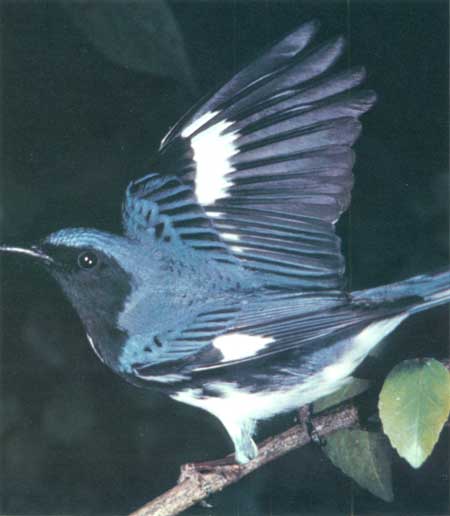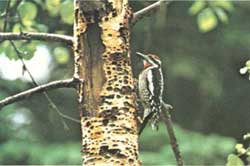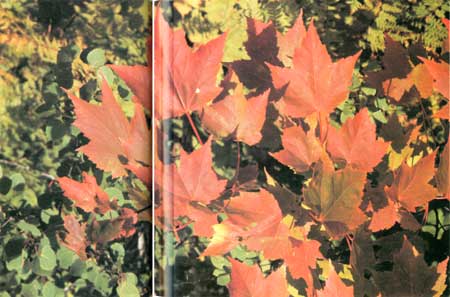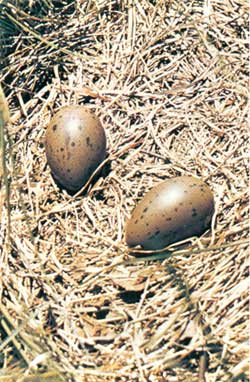|
ISLE ROYALE National Park |
 |
The Black-throated Blue Warbler: Maple-Birch Forest
Nervously the warbler works its way toward the tip of the branch, now peering under a leaf for insects, now cocking its head to look skyward for hawks. In a world of green and gray and brown, it is easy to spot. Pale blue-gray mantles its head and back; a band of black runs from its face to its flank; its breast and belly and the spot at the bend of each wing are pure white. To a hawk, it would be a small but conspicuous morsel.
The green, shady world of this particular black-throated blue warbler is a small piece of the forests of sugar maple and yellow birch that blanket Isle Royale's southwestern highlands. The warbler lives at one end of a rise in the undulating crest of Greenstone Ridge, about three miles from Windigo. The trees atop this steep-sided, elongate, 5-acre knoll are mostly sugar maples, with some yellow birches and miniature groves of white-cedar, while on the relatively level, partly wet ground at its base there are more yellow birches and some firs among the maples. It is a highly structured world: dense canopy above; next an open layer with lots of flying room; below that a layer of foliage ten to twenty feet above the ground formed by a multitude of sugar maple saplings; another open, nearly shrubless layer beneath that; and on the leaf-covered ground few plants but the tiny seedlings of sugar maple.

(Photo by B. Hall)
The warbler shares this shady knoll with two more mated black-throated blue warblers, and with several other species of birds. There are pairs of blue jays, Swainson's thrushes, hairy and downy woodpeckers, black-capped chickadees, black and white warblers, and broad-winged hawks. The red-eyed vireo, black-throated green warbler, and oven-bird are each represented by three pairs. Living amongst the birds are three red squirrels. Each species uses the hill's resources in a different way, gleaning different kinds of food from it or searching only certain parts of it. The squirrels, for instance, hunt mostly seeds and buds, the thrushes and oven-birds work the ground for insects, the woodpeckers drill tree trunks for the larvae within, the red-eyed vireos search the sapling foliage and the canopy for insects, and the broad-winged hawks hunt everywhere—for squirrels, birds, and, especially in the wet places around the knoll, for frogs and snakes.
The creatures of each species, except the hawks, claim only a part of the knoll, a piece big enough to provide food for themselves and their young. This territory they defend against others of their kind, which otherwise would compete with them for food. For the hawks, however, the knoll is only a small part of their territory, which extends over two on three square miles.
The black-throated blue warbler rarely sees vertebrate animals other than these. Occasionally a moose wanders through, browsing on young sugar maples as it goes. Hares that headquarter in the swampy woods nearby sometimes venture to the foot of the slope, and once in a while a red fox passes by. The warbler has never seen the two deer mice which some nights scamper up the leafy slopes, on the toads that chance by after the spring breeding season.
The warbler pauses in its hunt for insects to advertise its presence. "Zoo, zoo, zreeeee," it buzzes. An answering call comes from the male black-throated blue at the other end of the rise. At intervals it repeats the song, but it never comes closer. This is correct and satisfactory. The first warbler drops down to a young maple and then to the ground. It picks insects from a rotting log lying next to the bleached, half-buried bones of a cow moose killed here by wolves three winters before. The warbler cocks its head to watch the broad-winged hawk on its nest, thirty feet up in the fork of a yellow birch. The hawk is incubating eggs and poses no immediate threat.
With a beakful of insects the warbler flies to another log, beside which, in a low fork of a small maple, there is a neat little bark-adorned nest. Inside, the brownish female broods four tiny, naked young birds. Their faint "cheeps" are temporarily stilled as their father thrusts insects down their gaping throats. Then he flies up, up into the green vault arching above his world.
Walking southwest on the Greenstone Trail, one enters the maple-birch forest near the top of Mount Desor. After the long open ridges and young birch forests, it is like going into a tunnel. The sun and the views are screened off. One is forced to look at things close at hand, or to retreat to one's thoughts. On a hot day, the forest is a cool relief. On any day, it is an interesting change. Twelve miles down the trail, one finally emerges into daylight at Windigo.
 Yellow-bellied sapsuckers drill rows of holes in trees and later return to feed on sap and insects. A sugar maple-yellow birch forest (right) occupies the south slope of Sugar Mountain. (Photo by Greg Beaumont) |
Maple-birch forest also covers much of Red Oak Ridge southwestward from Siskiwit Lake, and some of Feldtmann Ridge. In future years it will probably reclaim several miles of Greenstone Ridge northeast from Mount Desor. This stretch, part of the 1936 burn area, is now covered with young birch and aspen, but underneath one sees thousands of small sugar maples awaiting their chance.
In general, the maple-birch forest occupies the warmest, driest parts of Isle Royale; this means the highlands farthest above the cooling influence of Lake Superior. But within the total area of the forest are many variations in environment, which in turn produce variations in the forest.
Of the several tree species making up this forest type, each has its specific requirements. Sugar maple, the generally dominant species, occupies the warmest, driest areas, which also have fairly deep, well-drained soils. Altitude and southerly slopes provide the first conditions, glacial deposits the second. The tops of Mount Desor and Sugar Mountain have nearly pure stands of sugar maple. Here nature was apparently "helped" by Indians, who girdled other trees to encourage the sweet-sapped maples. Outward from here, other species increasingly mix in. Yellow birch, the "second-in-command," needs somewhat more moisture, and its seedlings are somewhat less shade-tolerant than those of sugar maple. On lower parts of the ridges it shares dominance with sugar maple, and on Greenstone and Red Oak Ridges near Washington Harbor it takes over first place. White-cedar, perhaps third in importance, can tolerate both wetness and dryness. Therefore it occurs throughout the maple-birch area, and in many swampy places it becomes the principal tree. White spruce and balsam fir, the presiding species on most of Isle Royale, occur sparingly through the maple-birch forest, mainly on north slopes and in dips in the southerly slopes, where moisture accumulates. This forest, then, is distinctly a hardwood, deciduous forest. Intensely green in summer, skeletal in winter, it forms a striking contrast with the coniferous shoreline forests at the island's other environmental extreme.

(Photo by Robt. M. Linn)
Wherever sugar maple forms part of the overstory, it puts its structural stamp on the forest, as we saw on the warbler's knoll. It does this through prolific reproduction. So abundantly do its seeds germinate that the little maples often make a continuous cover over the ground, shading out most other plants. (The few herbaceous plants that do survive in these forests are mostly species found in other forest types as well—such as Canada dogwood, twisted-stalk, bluebead lily.) In areas where the canopy is closed, intercepting most of the sunlight, the maple seedlings remain small, waiting until the day a big tree falls, giving some a chance to grow. (Such blowdowns are rather infrequent, since trees here are better anchored and less susceptible to heart rot than those in the spruce-fir forest.) Where the canopy is more open, the young maples form an understory, vying with each other for ultimate positions in the overstory. In such a situation (again as on the warbler's knoll), the ground beneath the sapling maples is nearly bare, though even here tiny maple seedlings manage to survive—a potential third wave, as it were. The maple's fantastic ability to reproduce is also demonstrated in some fringe areas, where scarcely a mature maple can be found. Going down the Greenstone Trail on the last long descent to Windigo, you see beneath the birches thickets of the irrepressible sugar maple.

(Photo by R. Janke)
With few conifers and only small amounts of combustible material near the ground, most of the maple birch forest has escaped fire for a long time and has been able to reach maturity. For some animals that feed near the ground, this is a bad state of affairs. Deer mice find the pickings rather slim here. Hares, which need thick cover as well as low-growing plants to eat, generally are confined to the swampy coniferous pockets within the maple-birch area. Moose, though able to reach plenty of foliage, find very little diversity in the menu.
 This loon's nest was built on a tiny island in Tobin Harbor. (Photo by Robt. G. Johnsson) |
This forest is much more generous to those animals that can reach its upper levels. Red squirrels can harvest maple and birch seeds and the many fungi that grow on old trees—trees that also offer them numerous nesting cavities. Birds, though perhaps less abundant and diverse here than in some of the other forest types, nevertheless occur in good numbers. Most of them feast on the insects that are feeding on the upper foliage. The great majority of binds escape the winter harshness by migrating south. Easily the most common are the oven-bird and the red-eyed vireo. The oven-bird manages to find insects on the leafy forest floor, where it builds its domed nest. The red-eyed vireo hangs its little basket nest in the fork of an understory branch, and feeds upward into the canopy. You can hear its monotonous question-and-answer phrases all day long.
Considered now to be a relict of an earlier warm-dry period, when they were much more extensive, Isle Royale's maple-birch forests await the dictates of climatic change—expansion if the climate warms, extinction if it cools. Meanwhile they add pleasantly to the diversity of life and landscape on the island.

|

|
|
|
|
Last Modified: Sat, Nov 4 2006 10:00:00 pm PST |


